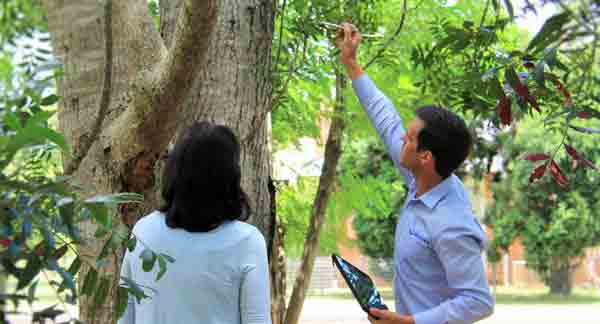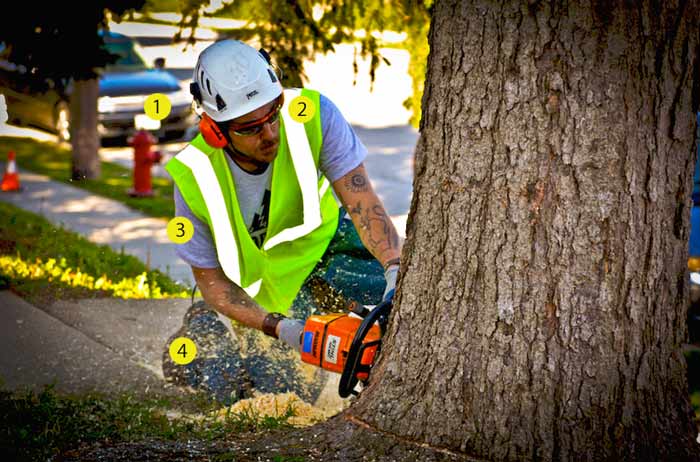What Arborists Do & Why They're Important?
An arborist is a professional in the field of arboriculture which is the study of the caring of trees shrubs and perennial plants. In real terms, an arborist or tree surgeon maintains the urban forest which involves pruning and removal of trees in confined spaces (suburbia).
The arbor industry has come a long way over the last 20 years and has seen rapid interest and growth due to its’ “green factor” with public awareness about the importance of trees in the urban landscape.
The industry has been slowly splitting into two main fields, the consulting arborist, who is a professional dealing solely with reports and recommendations. The other is a certified arborist who carries out any tree work such as tree pruning or removal as required.
Want Arborist Prices?: Go to our Arborist Cost Guide
This split has come about due to an increased awareness by local councils of the importance of maintaining the urban forest and the amenity value of single trees to their surroundings. All Australian councils have a Tree Preservation Order (TPO) which outlines rules for the removal of trees. These rules generally include a maximum height or spread of trees that can be pruned or removed without council approval.

Table of contents
ToggleArborist reports
These are normally requested by the council when a tree of significance in the urban environment is marked for removal. They require an AQL Cert. III arborist or greater to provide recommendations on the retention or removal of said tree.
Australian Qualifications Framework for Arboriculture
In Australia, we have an Australian Qualifications Framework (AQF) which outlines the skills required to be taught for arboriculture in each state. One of the main issues with the arbor industry is the lack of regulation and the ability of anyone who owns a chainsaw to advertise themselves as an arborist and begin removing or pruning trees.
Although there are courses and it is said you should have a minimum of Certificate III in Arboriculture, there is no regulation in Australia that requires a license number to operate. By comparison, other trades such as plumbing, electrical, or building all require a license.
New South Wales (NSW)
In NSW qualifications for arboriculture can be gained from TAFE. You can get a certificate or a diploma which varies from 2 – 5 years of part-time study.
Councils in New South Wales who have in the past only required a Certificate III to submit arborist reports for recommendations on trees, but are now more and more asking for a consulting arborist with a Diploma. This is where the industry is starting to divide with some arborists in Sydney choosing to specialize in arborist reports and others the grunt work of pruning or removing trees.
You should always check to see if council approval is needed before you remove a tree as fines can be quite substantial.
The arborists on the Central Coast of NSW which is an hour North of Sydney also seem to be going down the same route. And because there are just so many trees up that way, the demand for tree services and consulting arborists is very high and growing.
Newcastle arborists could also be grouped with the central coast, with a growing population and houses forever encroaching on the surrounding bushland, the demand for DA approval including trees to be taken down has seen an explosion over the past decades. Although not as numerous as in other cities, an arborist in Newcastle is certainly just as highly skilled and competent.
Victoria (VIC)
The main hub for education for arboriculture is in Melbourne through the Holmesglen or SWTafe. Again you have the choice to go government or private when getting your training. There are other places for Melburnians to consider such as Arbortrim.
Other options include:
- Melbourne Polytechnic
- University of Melbourne
- Sherbrooke Tree Service
- Tree Tech
South Australia (SA)
We of course have plenty of tree experts in the jewel of the south, the great city of Adelaide. Although arborist tree services in Adelaide mostly got their training to cut down trees in the city, there are some institutions in regional areas. The main government institution is TAFE SA. But being an in-demand industry and course there are a host of other places that provide training.
More arborist training facilities in Adelaide:
- ARO Education
- South Metropolitan (TAFE)
- Trees Net
- Sasa Trees
Western Australia (WA)
As the city of Perth has expanded over the years, the need for trees to be cleared that are encroaching on housing or that are in danger of being a fire hazard. Like most of Australia, there are plenty of places for arborists in Perth to get training such as The Trees Guild of WA, North Metro TAFE, and or Arbor Trim which is a private training facility.
Queensland (QLD)
Being a topical state, Queensland has its fair share of storms and cyclones. So work for tree surgeons in Brisbane can be feast and famine at times. Because of high winds, the arborist all over the North East including tree arborists Sunshine Coast and the Gold Coast need to be extra vigilant when assessing trees for potential faults.
Small weaknesses in large branch unions can be life and death during cyclones, so it is better to be safe than sorry when it comes to public safety.
Training is the same across all 3 cities, although there are more courses in Brisbane so Gold Coast arboriculture students tend to travel north for their studies. Government institutions being the most popular through TAFE, but there are also a host of other private places where you can obtain certification as an arborist in Queensland.
Arboriculture training facilities in QLD:
- Arboriculture Organisation
- Training for Trees
- Arbor Trim
- Interlink
Australia Capital Territory (ACT)
Most arborists in the ACT are pretty used to traveling for work. It comes with the territory. They will travel from 50 – 80km for a decent size job, so if you are in Canberra or the surrounds like Yass. Luckily there are several training institutions within Canberra for Arboriculture.
List of private and public education facilities:
- Canberra Institute of
- Technology CIT
- Skilled Capital
- Arbortrim
Recognition of prior learning
As courses for Arboriculture is fairly new in the grand scheme of things, there are plenty of tree surgeons who have been operating for 20 + years without any formal training. As these are now veterans of the industry, there is no need to go through the training at an official institution like TAFE. You can actually get recognized for your acquired skills by bypassing some fundamental testing by private institutions such as Arboriculture Australia Recognition of Prior Learning certificates.
Arborist Skill Base
One of the main focuses of the training and study an arborist undergoes is Occupational Health and Safety OHS. This includes everything from
- Safe use of chainsaws
- Prepare and apply chemicals
- Transport and store chemicals
- Recognising hazards on site
- Writing hazard reports before starting a job
- First aid training to provide cardiopulmonary resuscitation
- Ground-based rigging
- Single rope technique for scaling trees
- Aerial rigging
- Dismantle trees
- Undertake aerial rescue
- Removal of trees in confined spaces
- Working safely near live electrical apparatus as a non-electrical worker
- Working with poisonous trees
As you can see this is just some of the things that all need high attention to detail when looking to remove or prune trees in a confined space such as in a backyard or anywhere humans live, work, or frequent foot traffic.

Safety standards for Arbor Industry
Certified arborists near you are trained to Australian standards for a wide range of tasks specific (but not isolated to) the arbor industry.
Below is a list of some of the Australian standards your tree care professional should be trained in.
Most of the below are covered in the Certificate II and Certificate III courses in Arboriculture, so their certificate is proof they are trained to carry out the tasks in a safe manner and to industry standards.
AS 4373:2007 – Pruning of amenity trees
AS 4970-2009 – Protection of trees on development sites
AS 4970-2009- AMDT 1 Protection of trees on development sites
AS 2303:2015 Tree Stock for landscape use
AS 2727 – 1997 – Chainsaws Guide to safe working practices
TRC2005A – Fell Small Trees
AS 2726.1 – 2004 Chainsaws – Safety requirements – Chainsaws for general use
AS 2726.2 – 2004 Chainsaws – Safety requirements – Chainsaws for tree service
AS 2550.10 – 1994 Cranes – Safe use – Elevating work platforms
AS 1418.10 (Int) – 2004 Cranes, hoists and winches – Elevating work platforms
AS/NZS 1891. 1: 2007 Industrial fall-arrest systems and devices – Harnesses and ancillary equipment
AS/NZS 1891:1997 Occupational protective helmets
AS/NZS 1270:2002 Acoustics – Hearing protectors
AS/NZS 1337:1992 Eye protectors for industrial applications
AS/NZS 2210. 1:1994 Occupational protective footwear – Guide to selection, care, and use
AS/NZS 4453.3: 1997 Protective clothing for users of hand-held chainsaws – Protective legwear
AS/NZS 4602:1999 High visibility safety garments
Qualifications Held by Certified Arborists
All tree services sent to quote your tree job as recommended by GoTreeQuotes are certified professionals at Arbor Operations. They are all more than capable of carrying out any tree-related task you throw at them.
The list below encompasses all qualifications held by arborists working in conjunction with Go Tree Quotes; however, the list may vary from contractor to contractor.
We have highlighted the minimum certification held by all tree surgeons who will be quoting your tree job.
Certificate I – Horticulture (Arboriculture), WH&S, First Aid
Certificate II – Horticulture (Arboriculture)
Certificate III – Horticulture (Arboriculture)
Diploma Level V – Horticulture (Arboriculture)
Qualified Tree Risk Assessment
Level I – Chainsaw Operation/Woodchipper Operation
Level II – Chainsaw Operation/Woodchipper Operation
Chainsaw Operators Ticket
Construction White Card
ACDC Licence Chemical Application
Traffic Control & Placement of Road Signs
Elevated Work Platform Ticket
Elevated Work Platform Rescue
Electrical Awareness
Work near powerlines ticket
First Aid Resuscitation
Aerial Rescue
Environment (Awareness & Impact)
Bobcat Ticket
Loader/Excavator
HR/MR Truck License
WAMS Electrical Competency
Wood Chipper Operation
Best Practices
Go Tree Quotes is committed to arborists using the method of ‘BEST PRACTICE’. This is a technique or methodology that is accepted as superior to any alternatives for commercial or professional procedures that are accepted and perceived as being the most correct for results that are superior to those achieved by other means.
Our expectation of tree contractors we work with as such is to do everything in their power, using their knowledge and experience to uphold these values.
Arborist network across Australia
Go Tree Quotes work with some of the best arboists in Australia like in Sydney, Melbourne, Brisbane, Gold Coast, Sunshine Coast, Newcastle, Central Coast, Canberra and Adelaide.












